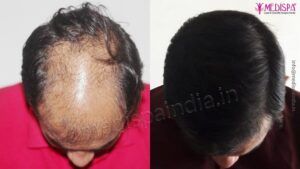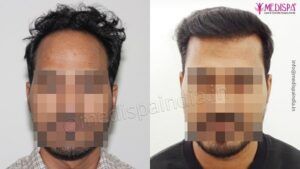
Gone are the days of outdated hair transplant techniques that yielded unpredictable results and limited reliability. Thanks to modern technology, the younger generation now has access to top-notch facilities and the highest levels of productivity, surpassing previous advancements. These breakthroughs have made it easier to achieve undetectable and natural-looking results in the field of hair transplantation.
While significant progress has been made in terms of successful outcomes, relying solely on these improvements would not be wise. The key to achieving excellent results lies in the effective combination of the latest technology and the surgeon’s expertise. A hair transplant is a cosmetic procedure that involves transferring hair follicles from the donor area to the recipient area. The basic steps of the procedure include:
- Administering local anesthesia
- Extracting grafts from the donor site using any necessary bodily component
- Separating the grafts (used in the FUT method)
- Implanting the hair follicles into the recipient area.
Various methods for hair transplant
The procedure for hair transplant involves the use of two distinct techniques, each with its own method of graft harvesting. These techniques are as follows:
- Strip technique (FUT hair transplant technique): This technique involves the removal of a thin strip of hair from the donor area. The strip is then dissected to retrieve individual grafts, which are subsequently transplanted to the recipient site. The strip technique is typically chosen for cases of extensive baldness, where a larger number of grafts (approximately 3000-3500) are required.
- FUE technique (Follicular Unit Extraction): The FUE technique involves the extraction of individual hair follicles from the donor area using a punch device. These follicles are then directly transplanted to the recipient site. It is important to perform each step of this technique under magnification and with great care, as there is a higher risk of damage to the hair follicles due to the extraction process being based on assumptions. The FUE technique is primarily used for initial baldness cases and for facial hair transplants, such as beard, moustache, and eyebrows. This technique allows for the harvesting of a maximum of 2000-2500 hair grafts.
- Combination technique of FUT and FUE: The combination technique was developed to meet the demand for high-density hair transplants and cases of extensive baldness, which are increasingly common. This technique allows for the harvesting of more than 4000 hair grafts. The procedure begins with the FUT technique, which is used to harvest the majority of the grafts (approximately 3000-3500 hair grafts). Then, the FUE technique is employed to extract the remaining number of grafts (approximately 1500 grafts). This combination technique offers long-term benefits, as it allows for future sessions up to three times.
Overall, these different techniques for male hair transplant provide options for various degrees of baldness and desired hair density, ensuring that each patient’s specific needs can be addressed effectively.
Hair transplantation: The most effective solution for genetic baldness
This surgical procedure requires the expertise of a licensed medical professional in order to ensure successful and safe results. It is crucial to carefully select a reputable hair transplant clinic to achieve the best outcomes.
There are numerous clinics that offer hair transplant services, but it is important to ensure that the quality of their services is of the highest standard. When choosing a hair transplant clinic, several factors should be taken into consideration.
If you are experiencing hair loss and are eligible for the procedure, hair transplantation is undoubtedly the best option for you. It provides a permanent solution to address your hair loss, and when performed by a skilled surgeon, the results will appear natural. You will be able to witness your hair regrowing naturally in the previously bald areas.
Hair transplantation is the most practical and effective treatment for permanent baldness, which requires medical attention.
What makes FUT the preferred method?
In recent years, there has been a lot of confusion surrounding the best hair transplant strategy, largely due to commercials and endorsements. In an ideal world, it would be difficult to declare one approach superior to another, as each technique has its own unique indicators.
The FUT hair transplant procedure is considered the best method in cases where a larger number of hair follicles are required. This is because a surgeon can harvest 3000-3500 hair grafts in a single session with minimal harm to the hair follicles, thanks to enhanced visibility.
On the other hand, FUE hair transplants are more suitable for facial hair transplants or cases of early hair loss that require fewer hair follicles. In a single session, this procedure can extract around 2000-2500 hair grafts. However, it is not recommended when the donor hair density is insufficient, as it is a blind procedure and may cause additional harm to the hair root if not performed by a professional.
Unlike FUE hair transplant, FUT hair transplant preserves the donor area for future sessions since the hair grafts are collected from a smaller region. If you are interested in learning more about the best hair loss treatment options, you can visit Medispa hair transplant clinics in Delhi and Jaipur.
Healing and recovery
Recovery after a hair transplant procedure is relatively easy and painless. The patient can go home the same day and resume their normal activities the following day, although they should avoid any strenuous work for about a month. It is important for patients to strictly follow the post-procedure instructions for at least a week to ensure proper healing. Any physical complications should subside within a week.
It is normal for the transplanted hairs to start shedding a few days after the procedure. However, after about 3 months, you will begin to see new hair growth, which becomes more noticeable by around 6 months. It takes approximately 9 months to 1 year for complete hair growth to be visible.







